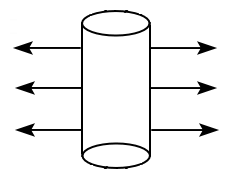A metallic spherical shell has an inner radius \(R_1\) and an outer radius \(R_2.\) A point charge \(Q\) is placed at the center of the spherical cavity. What are the surface charge densities \(\sigma_{in}\) and \(\sigma_{out}\) on the inner and outer surfaces of the shell, respectively?
1. \(\sigma_{in} = -\dfrac{Q}{4\pi R_1^2},~ \sigma_{out}=\dfrac{Q}{4\pi R_2^2}\)
2. \(\sigma_{in} = \dfrac{Q}{4\pi R_1^2},~ \sigma_{out}=0\)
3. \(\sigma_{in} = 0,~ \sigma_{out}=\dfrac{Q}{4\pi R_2^2}\)
4. \(\sigma_{in} = \dfrac{Q}{4\pi R_1^2},~ \sigma_{out}=-\dfrac{Q}{4\pi R_2^2}\)
1. \(\sigma_{in} = -\dfrac{Q}{4\pi R_1^2},~ \sigma_{out}=\dfrac{Q}{4\pi R_2^2}\)
2. \(\sigma_{in} = \dfrac{Q}{4\pi R_1^2},~ \sigma_{out}=0\)
3. \(\sigma_{in} = 0,~ \sigma_{out}=\dfrac{Q}{4\pi R_2^2}\)
4. \(\sigma_{in} = \dfrac{Q}{4\pi R_1^2},~ \sigma_{out}=-\dfrac{Q}{4\pi R_2^2}\)

| 1. |  |
| 2. |  |
| 3. |  |
| 4. |  |
What will be the total flux through the faces of the cube as given in the figure with a side of length 'a' if a charge q is placed at?
Match the following:
| Column I | Column II | ||
| (a) | a corner of the cube | (i) | \(\phi=\dfrac{q}{2\epsilon_0}\) |
| (b) | mid-point of an edge of the cube | (ii) | \(\phi=\dfrac{q}{8\epsilon_0}\) |
| (c) | centre of a face of the cube | (iii) | \(\phi=\dfrac{q}{2\epsilon_0}\) |
| (d) | mid-point of B and C | (iv) | \(\phi=\dfrac{q}{4\epsilon_0}\) |
| 1. | (A)\(\rightarrow \)(iv), (B)\(\rightarrow \)(ii), (C)\(\rightarrow \)(iii), (D)\(\rightarrow \)(i) |
| 2. | (A)\(\rightarrow \)(ii), (B)\(\rightarrow \)(iv), (C)\(\rightarrow \)(i), (D)\(\rightarrow \)(iii) |
| 3. | (A)\(\rightarrow \)(iii), (B)\(\rightarrow \)(ii), (C)\(\rightarrow \)(iv), (D)\(\rightarrow \)(i) |
| 4. | (A)\(\rightarrow \)(i), (B)\(\rightarrow \)(iii), (C)\(\rightarrow \)(ii), (D)\(\rightarrow \)(iv) |
A paisa coin is made up of \(Al-Mg\) alloy and weighs \(0.75~\text g.\) It has a square shape and its diagonal measures \(17~\text{mm}.\) It is electrically neutral and contains equal amounts of positive and negative charges. Treating the paisa coin as if it were made up of only Aluminum \(Al,\) find the magnitude of the equal number of positive and negative charges. What conclusion do you draw from this magnitude?
| 1. | \(3.48\times 10^4~\text C, \) everyday objects contain enormous amounts of charge |
| 2. | \(5.4\times 10^4~\text C, \) The net charge of neutral objects is always significant |
| 3. | \(1.34\times 10^4~\text C, \) The positive and negative charges in neutral objects perfectly cancel out |
| 4. | \(1.34\times 10^4~\text C, \) The amount of positive and negative charge in neutral objects is negligible |
A paisa coin is electrically neutral and contains equal amounts of positive and negative charge of magnitude \(34.8~\text{kC}\)34.8 kC. Suppose that these equal charges were concentrated in two-point charges separated by 1 cm, 100 m and 106 m . Find the force on each such point charge in each of the three cases respectively.
1. \(1.09\times10^{23}~\text{N},~1.09\times10^{15}~\text{N}~\text{and}~1.09\times10^{7}~\text{N}\)
2. \(1.09\times10^{22}~\text{N},~1.09\times10^{15}~\text{N}~\text{and}~1.09\times10^{7}~\text{N}\)
3. \(1.09\times10^{23}~\text{N},~1.09\times10^{14}~\text{N}~\text{and}~1.09\times10^{8}~\text{N}\)
4. \(1.09\times10^{22}~\text{N},~1.09\times10^{15}~\text{N}~\text{and}~1.09\times10^{7}~\text{N}\)
The figure represents a crystal unit of caesium chloride, CsCl. The caesium atoms, represented by open circles are situated at the corners of a cube of side 0.40 nm, whereas a Cl-atom is situated at the centre of the cube. The Cs-atoms are deficient in one electron while the Cl-atom carries an excess electron. What is the net electric field \(E_{net}\) on the Cl-atom due to eight Cs-atoms, and suppose that the Cs-atom at corner A is missing. What is the net force \(F_{net}\) now on the Cl-atom due to seven remaining Cs-atoms?
| 1. | \(E_{net}=1.2 \times 10^9 ~\text{NC}^{-1},~F_{net} = 1.92 \times 10^{-9}~\text N\) |
| 2. | \(E_{net}=0~\text{NC}^{-1},~F_{net} = 1.92 \times 10^{-9}~\text N\) |
| 3. | \(E_{net}=0~\text{NC}^{-1},~F_{net} = 0~\text N\) |
| 4. | \(E_{net}=1.2\times 10^9~\text{NC}^{-1},~F_{net} = 0~\text N\) |
Two charges \(q\) and \(-3q\) are placed fixed on \(x\)-axis separated by distance \(d.\) Where should a third charge \(2q\) be placed such that it will not experience any force?
| 1. | At a distance \(\dfrac{d}{\sqrt3 -2}\) to the left of charge \(q\) |
| 2. | At a distance \(\dfrac{d(\sqrt3 +1)}2\) to the left of charge \(q\) |
| 3. | At a distance \(\dfrac{d}{2}\) to the right of charge \(-3q\) |
| 4. | Midway between \(q\) and \(-3q\) |
The figure shows the electric field lines around three-point charges A, B and C.

In which region or regions of the picture could the electric field be zero?
(a) Near A
(b) Near B
(c) Near C
(d) Nowhere
1. \(\phi_E =\dfrac{q}{\epsilon_0}\)
2. \(\phi_E =\dfrac{2q}{\epsilon_0}\)
3. \(\phi_E =\dfrac{p}{\epsilon_0 r^2}\)
4. \(\phi_E = 0\)
| (a) | if \(q>0\) and is displaced away from the centre in the plane of the ring, it will be pushed back towards the centre. |
| (b) | if \(q<0\) and is displaced away from the centre in the plane of the ring, it will never return to the centre and will continue moving till it hits the ring. |
| (c) | if \(q<0\), it will perform SHM for small displacement along the axis. |
| (d) | q at the centre of the ring is in an unstable equilibrium within the plane of the ring for \(q>0\). |
1. (a), (b), (c)
2. (a), (c), (d)
3. (b), (c), (d)
4. (c), (d)









